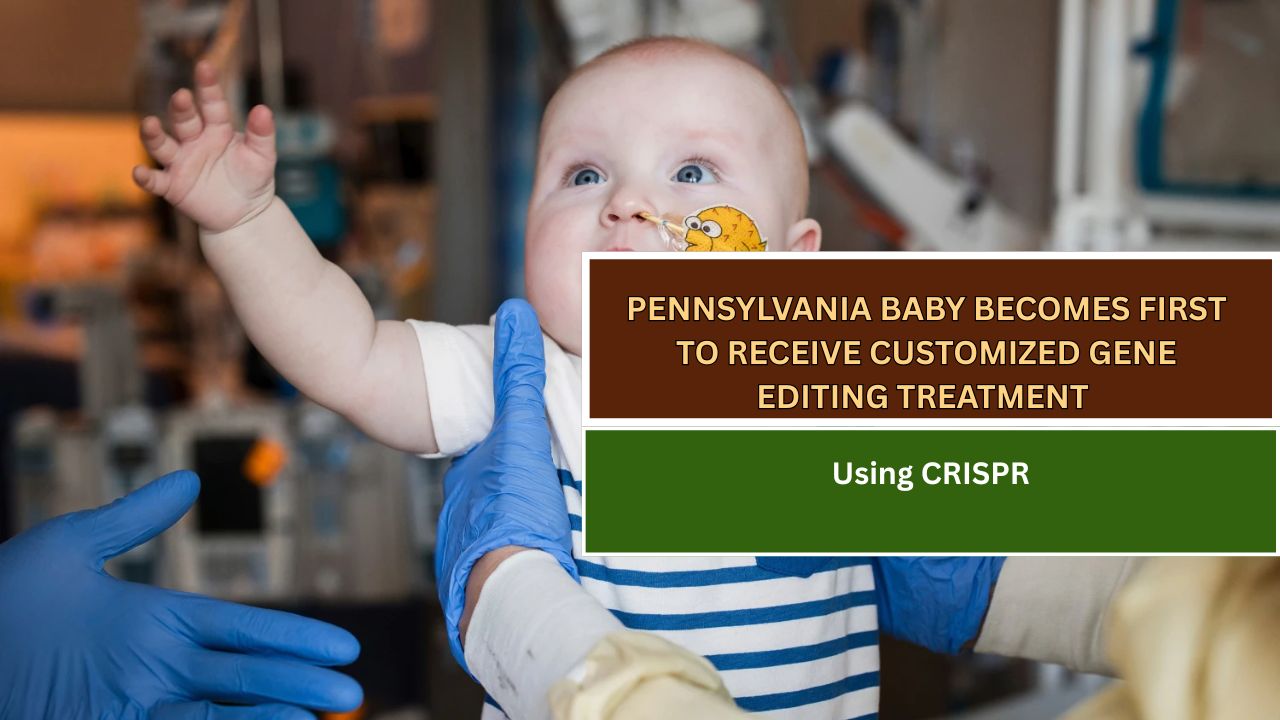Doctors have successfully treated a Pennsylvania infant with a rare genetic disorder using a personalized gene therapy, marking a significant breakthrough in the field of medicine.
The case, published in the New England Journal of Medicine, highlights the successful use of CRISPR—a gene editing tool—to create a custom therapy tailored specifically to the baby’s genetic mutation. Experts say this approach could pave the way for treating millions with rare conditions.
“This is the first step toward using gene editing therapies to treat a wide variety of rare genetic disorders for which there are currently no definitive medical treatments,” said Dr. Kiran Musunuru, gene editing specialist at the University of Pennsylvania and co-author of the study.
A Lifesaving Decision
KJ Muldoon, an infant from Clifton Heights, Pennsylvania, was born with CPS1 deficiency, a condition so rare it affects roughly one in a million babies. The disorder prevents the body from clearing ammonia from the blood, which can become toxic. Without intervention, many infants die early.
Faced with bleak odds, KJ’s parents, Kyle and Nicole Muldoon, weighed their options between a high-risk liver transplant or an unproven gene therapy.
“We prayed, we talked to people, we gathered information, and we eventually decided this was the way we were going to go,” Kyle said.
CRISPR and Base Editing in Action
Within six months, researchers at Children’s Hospital of Philadelphia (CHOP) and Penn Medicine developed a therapy using base editing, a newer form of CRISPR. Rather than cutting the DNA, base editing swaps a single faulty letter in the DNA sequence, reducing the risk of off-target changes.
“It’s very exciting that the team created the therapy so quickly,” said Senthil Bhoopalan, a gene therapy researcher at St. Jude Children’s Research Hospital, who was not involved in the study.
In February, KJ received his first IV infusion of the gene therapy, delivered via lipid nanoparticles, which carry the treatment to liver cells. Follow-up doses in March and April allowed KJ to start eating more normally and handle common childhood illnesses better.
“He slept through the entire thing,” said Dr. Rebecca Ahrens-Nicklas, a gene therapy expert at CHOP and study co-author.
Early Signs of Progress
Now 9½ months old, KJ requires fewer medications and continues to show signs of normal development. For his parents, even small milestones like waving or rolling over are meaningful victories.
“Every time we see even the smallest milestone that he’s meeting—that’s a big moment for us,” said Nicole.
Still, researchers urge caution. It will take years of follow-up to fully understand the long-term effects of the therapy.
“We’re still very much in the early stages,” said Ahrens-Nicklas. “But every day, he’s showing us signs that he’s growing and thriving.”
Hope for Rare Disease Patients
KJ’s case brings renewed optimism for the 350 million people worldwide living with rare diseases, most of which are genetic. These individuals are often overlooked by traditional gene therapy due to the high cost and low commercial incentive for drugmakers.
“This research sets the pace and the benchmark for such approaches,” said Bhoopalan.
The first FDA-approved CRISPR therapy in the U.S. treats sickle cell disease, a much more common condition. But Musunuru and his team demonstrated that custom therapies can be developed affordably. He said the cost was comparable to an $800,000 liver transplant, suggesting potential cost parity in the future.
“As we improve and speed up development, economies of scale will kick in,” said Musunuru. “I expect the costs to come down.”
Carlos Moraes, a neurology professor at the University of Miami, said this breakthrough will inspire other teams.
“Once someone comes with a breakthrough like this, it will take no time for others to apply the lessons,” he said. “I predict the barriers will be crossed in the next five to 10 years.”
This article has been carefully fact-checked by our editorial team to ensure accuracy and eliminate any misleading information. We are committed to maintaining the highest standards of integrity in our content.

Outside of work, he enjoys playing chess, following cricket, and writing short stories. His commitment to integrity and in-depth analysis strengthens OTE News’ mission of providing trustworthy journalism.



